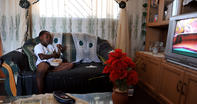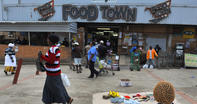Numbers Higher than Expected
Research was conducted by the African Food Security Urban Network (AFSUN) examining levels of food security among poor, urban households in many of the big Southern African Development Community (SADC) region cities.

Families were asked questions such as how often they had reduced their meal size or how often they went without any food in a day. The results showed that numbers were much higher than expected. In poor communities in Cape Town, 80% of households were either moderately or severely food insecure.
And it isn’t something people speak about, probably because there is an element of shame in not being able to feed your family. If you’re without a house or running water, that’s a service delivery problem with the state. But, if you’re without food, whose problem is it? All these households have different coping strategies, but no one really speaks about it.
States of Food Insecurity
Households are regarded as highly food secure if the people living there have constant access to adequate food without difficulties or anxiety. It is marginally food secure if the people experience occasional difficulty or anxiety around accessing adequate food, but the quality, quantity and variety of their food intake is not substantially reduced.
This incorporates an emotional and psychological component. It is not just about having a full belly, it’s about the fear of not being able to fill one’s belly. Low food security occurs when the quality and variety of food intake is reduced, but the quantity of food intake and normal eating patterns are not substantially disrupted.
At this level it is easy for people to pick up weight in spite of falling on the lower end of the food security gauge. If they stay in this state for a length of time their bodies begin to leach the critical micronutrients needed to stay healthy and fit. A family has very low food security if the quantity of food intake and normal eating patterns are disrupted at certain times of the year due to a lack of money or other resources used to access food.
At this level the family is both receiving a low nutrient intake and the number of calories the are getting in a day is falling away. This state of food insecurity is more obvious to the eye as the person’s weight drops. Any of the states of food insecurity could either be like a passing storm front - painful and anxiety-provoking but 'transitory' - or could become the prolonged climate for a family, becoming 'chronic'.
In its chronic form, food insecurity translates into a high degree of vulnerability to ill health, delayed development as well as increased infant mortality (in severe and extreme cases). Consequently, the effects of poor health among poorer people manifest in various ways and, within households, are often associated with diminished ability to obtain work and to generate income.'
The Cash Economy

Nationally, South Africa is regarded as food secure. It grows enough for everyone and has enough to export. Yet 14 - 52 per cent of households have been shown to be food insecure. At the end of the last decade the hunger scale index found that half of all South Africans experienced hunger and a third were at risk of hunger.
This is because only 5 per cent of South African families rely on food production - agriculture - as their main source of food. And a fifth of the country supplemented their household food supply using agriculture. Almost every South African - even in the most rural, subsistence economies - gets some of his or her food through exchanging cash for goods.
This means that everyone in this country needs, in some way, to be part of a cash economy and cash remains critical for families in terms of ensuring they have access to healthy, culturally appropriate, safe food every day to meet their needs for a healthy and active life. In this way, South Africa’s poorest of the poor are most vulnerable as they do not have a financial means to sidestep the blows that come with economic shocks like sudden price hikes.
This, however, does not mean that more affluent households are impervious to the ripples along the food value chain. Their vulnerability is not in terms of sudden price hikes or a threat to a breadwinners immediate income. They probably buy higher-end food so even if their food budget was cut, they could absorb this by shopping down or use credit to buy food now and pay later. These people are more vulnerable to changes in the efficient but extremely fragile food supply chain.
Urban Poverty
Until now, most research on food security, and the resulting developmental programmes, was aimed at rural subsistence populations. With 85 percent of South Africa’s poor living rurally, and since poverty and food insecurity are inextricably linked, it is hardly surprising that relieving the burden of hunger in the countryside has been a government priority – and how better to do that than through pushing for agricultural development in rural areas?
People in these parts are often so poor that they cannot get even their basic daily energy needs, before even talking about nutritional needs. But this position has become stagnant and is not keeping pace with the metamorphosing population in southern Africa. As more and more people drift towards the city in search of work or the hope of a better life, they take their poverty with them.
This is why it has been championed for food security thinkers to swing their gaze away from the rural poor, where it has been focused almost exclusively until now, and train it instead on the new seat of food insecurity: our cities. Sub-Saharan Africa is the fastest-urbanising area in the world, and South Africa is the most urbanised country in the region, meaning the face of poverty is increasingly urban. It has been estimated that five-sixths of the new global poor will be urban-based.
Contradictions in our Cityscapes
Not only are our cityscapes getting bigger and soaking up more of the region’s populace, but they’re also a cacophony of contradictions: pulsing within the chest cavity of our cities are chrome and glass testimonials to modernity and the cardiac system of a developed world economy.
Yet a few kilometres away are the sprawling slums of people living in abject poverty, where social decay epitomises the creeping gangrene of communities that are starved of the economic oxygen they need to be strong, dextrous and contributing limbs on the broader body of urban life. South Africa’s cities have amongst the greatest divide between rich and poor in the world.
The very geography of the city reflects this divide, impacting on different communities’ access to jobs, transport, education, shops and the like – all elements that impact, on some level, on how people buy, carry, store and use food. Understanding this is helpful to get a mental grasp on the broader issues at play in the food security discussion.
And this is what is needed to strategise on food security as a geographer, or a funder, or a policy maker. What does food security mean for a person who carries a basket up and down the aisle of a trading store or greengrocer or supermarket once a week or once a month when they do that thing that families and communities have been doing for the 200 000 years that modern humans have been walking this planet: foraging for food for yourself and your family?
By Leonie Joubert